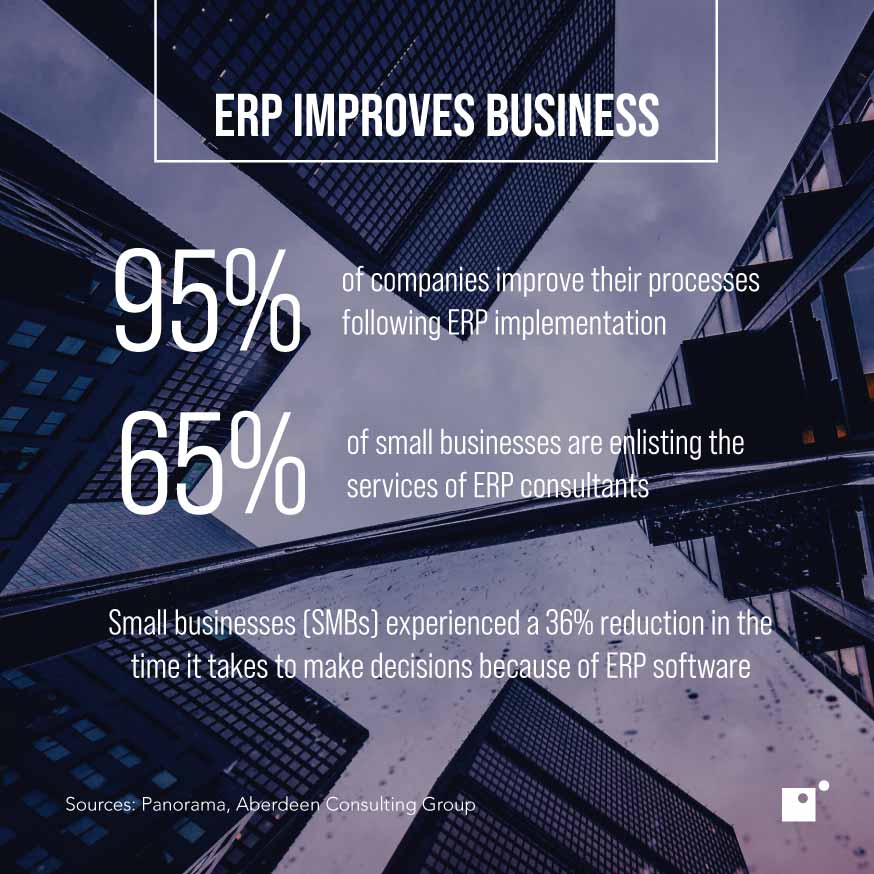What are the competitive advantages of enterprise resource planning that businesses can gain through its implementation?
This is the key question we’re going to be discussing today because ERP systems have become a common point of interest for organizations looking to transform their operations.
With digital transformation now a fact of life for companies of all sizes, many of them find themselves asking what they should transform first, and ERP is often seen as a high-priority candidate for tech adoption.
In this blog, we’re going to be taking a look at the competitive advantages of enterprise resource planning, whom ERP is appropriate for, and whether you should consider upgrading or replacing your current ERP system.
For the purposes of this article, we will be almost exclusively referring to cloud ERP solutions.
This is simply because the vast majority (85%) of ERP users use either cloud SaaS (software-as-a-service) ERPs or private cloud ERPs, with just 15% of ERP users opting for on-premise software; with many of these being leftover legacy systems.
The State of Enterprise Resource Planning (ERP) Adoption
As we just mentioned, ERP cloud adoption in particular has seen a big rise in recent years.
This is principally because of a few key factors.
Firstly, cloud solutions offer a level of flexibility and scalability that older legacy solutions can’t.
The flexibility comes from cloud ERPs catering to modern operational expectations that businesses have today—primarily concerning the need to be able to access the ERP and its modules on the go from any device.
The principle reasons among businesses for implementing ERP are to increase efficiency (25% of businesses), support growth (20%), allow for greater functionality (20%), consolidate disparate systems (10%), and replace legacy software (9%).
This, of course, is a level of flexibility that has become even more necessary because of the pandemic and the number of employees who conduct their work on a remote or semi-remote basis.
Remote working conditions have long been on the rise in any event, but the pandemic sped this up significantly, meaning an ERP that can offer full working flexibility became an important benefit to have.
As far as scalability is concerned, cloud ERPs have been increasingly in demand because businesses are able to much more easily adjust their subscriptions depending on their needs at a given time.
Unlike on-premise software, which has typically required organizations to host it on their own servers, cloud ERPs are hosted in data centers provided by the vendor.
Because of the kinds of data centers leading ERP providers like Microsoft can invest in, these cloud servers are typically extremely secure and fully redundant, usually utilizing Tier III or Tier IV servers that are beyond what an average SMB could feasibly afford.
When the needs of a business change (like needing more licenses, adopting more modules, or even downsizing after layoffs), the solution can expand or retract painlessly in comparison to having to upgrade a physical onsite server or being lumbered with a server that exceeds current needs.
Businesses are increasingly replacing older systems, with 32% of respondents in a 2021 survey indicating their recent technology initiatives involved replacing legacy solutions.
Cloud ERPs are therefore seen as the best option for the majority of modern businesses of all sizes to adopt, and that’s one of the key reasons cloud adoption of enterprise resource planning systems has risen so significantly in recent years.
Related Post: 2021 Enterprise Resource Planning Stats and Facts
Competitive Advantages of Enterprise Resource Planning
Implementing a new enterprise resource planning system or upgrading an existing one brings with it several benefits that provide competitive advantages for businesses.
Let’s take a look at some of the key advantages that can be gained from ERP adoption.
Efficiency
Implementing an ERP doesn’t just mean having a flexible and scalable cloud version of a legacy ERP—it also provides new opportunities that were previously not possible.
Enterprise resource planning is called what it is because its focus is on centralizing business processes into one system, thereby removing unnecessary, siloed, and duplicate processes.
By integrating every computer system of an organization; finance, human resources, planning, sales, marketing, and more, companies are able to organize their departments company-wide and avoid common inefficiencies brought about as a result of departmental siloing.
As far as organizational improvements are concerned, just 5% of businesses say that ERP did not improve their processes, with 49% stating they improved all business processes and 46% stating they improved their key processes.
Decision Making
For many organizations, one of the primary reasons they want to invest in an ERP solution is that it improves the efficiency of their operational processes.
This is often done through the improved visibility that decision-makers have over their operations.
In manufacturing, for example—an industry in which ERP uptake is more prevalent than most others—visibility over an entire supply chain provides substantial competitive benefits over those who lack such visibility.
When asked in a survey how ERPs helped their operations the most, organizations were in most agreement that their ERP “allows co-creation of new applications using data and business logic from different departments.”
Having an ERP system in place means analytics capabilities can be leveraged, which for certain industries like logistics can mean having a much clearer understanding of the effects of seasonal demand on their supply chain and adjusting accordingly.
Aside from this, this kind of analytical capability can translate to other areas too, like sales and marketing, where decision-makers can better identify how leads and prospects are progressing through their funnel and center their campaigns on initiatives that are data-driven.
Resources
One of the key considerations businesses have to make today is how to pool their resources and how to make the best use of the data sets at their disposal.
Organizations today house a lot of data on both themselves and their customers—how these resources are utilized is often the difference between a business that can respond effectively to its customers and one that can’t.
With data privacy and new regulations becoming a frequent fixture in business, companies must consider how they approach the handling of the resources—information and data—they own and how they can be used for the benefit of the organization.
As far as ERP is concerned, the ability of enterprise resource planning to allow access to resources company-wide through a single interface means faster, more reliable access to required information regardless of the department.
Driving Transformation
The vast majority of businesses today understand the importance of digital transformation to their future success and most have embarked on a digitization strategy of some kind.
Whether this is a full-scale ERP implementation or something simpler like an upgraded printer fleet, the transformation of business processes is seen as a crucial aspect of staying competitive in organizations today.
Digital business transformation as an objective is most common among SAP customers (58% of projects being business transformation), followed by Oracle (48%), and Microsoft Dynamics (44%).
Enterprise resource planning is viewed as an important component of a wider, comprehensive digital transformation project and as such is pursued by many SMBs seeking to get a competitive advantage.
This has been even more the case as ERP solutions and products have become more accessible to small and mid-sized businesses.
Communication
As far as technology solutions are concerned, it’s historically been the case that different departments within companies will use their own systems—what’s used on the warehouse floor will likely be disparate from what’s used in Sales.
What this has led to in many organizations is a structure where data, people, and processes are not linked across the company as a whole, which invariably leads to missed business opportunities.
Big data, the large sets of information that most businesses now handle, can be leveraged through an ERP to deliver actionable insights and a more streamlined operation.
This is done by integrating the various modules that different departments use for their work into the central ERP, allowing users to share data and information with each other far more effectively.
Collaboration was cited as the third most significant benefit established from implementing an ERP system, only behind reduced process times and having a centralized data system.
Businesses that can offer their staff and departments a system suite that allows for the opportunity to share and leverage data effectively have a big advantage over those that have no system for centralizing data and communication in place.
Bottom Line
As businesses increasingly find themselves operating in an environment that is driven almost exclusively by data, how efficient they are at being able to leverage their data sets is a key competitive differentiator in the success of a modern company.
Enterprise resource planning centralizes data and departments and brings together business operations through a single software application.
This allows for more efficient business processes through improved alignment; increased leveraging of data for decision-making; a more effective grouping of data for ease-of-use and compliance purposes; a launching point for wider digital transformation projects; and a greater ability for departments to communicate and collaborate.
In short, the competitive advantages of enterprise resource planning are many, and that’s why the majority of organizations today are looking to adopt cloud ERP for their business.
Subscribe to our blog to receive monthly insights into business technology and stay up to date with marketing, cybersecurity, and other tech news and trends.


